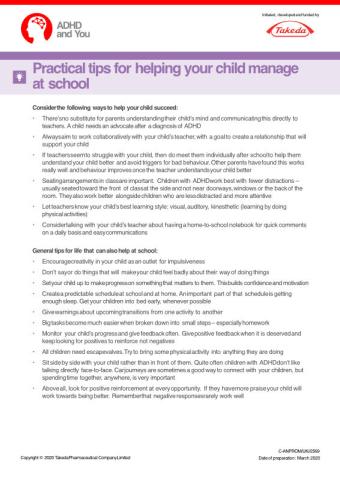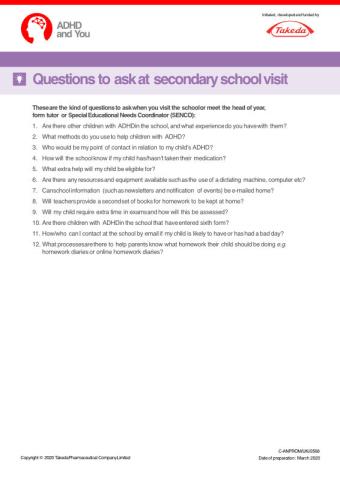Helping your child's educational development
Choosing a secondary school
 You may have a choice of secondary school and choosing the right one can be a big decision. It is something that all parents (and children) find difficult, even without having to think about ADHD.
You may have a choice of secondary school and choosing the right one can be a big decision. It is something that all parents (and children) find difficult, even without having to think about ADHD.
The following will help you make the most informed choice.
Exam results don’t tell the whole story
Remember that your local school with the best exam results or highest OFSTED (Office for Standards in Education, Children’s Services and Skills) rating may not be the best school for your child. School league table positions do not show whether your child will receive the best support or be happy there.
Which is the most ADHD-friendly school in your area?
An ADHD-friendly school is likely to have a caring atmosphere, a good support system for children who are having problems and experience of children with ADHD. So, take a closer look at the schools in your area for these qualities.

Talk to the SENCO*
A SENCO is a Special Educational Needs Coordinator, a teacher with specific training, whose job is to provide extra help and support for children with special educational needs. Aim to make an appointment to see the SENCO at the school and make an assessment of how ADHD is supported in that school.
*or equivalent position if situated outside of England
Get the views of other parents
Your local ADHD support group may be able to put you in touch with other parents of children with ADHD who are already at local secondary schools. This way you may be able to benefit from their experience.
Visits and practice runs
Parents (and children) can find it useful to visit the chosen secondary school for practice runs, so the child does not feel as anxious and can visit their future classrooms and meet their teachers.
Questions to ask
 These are the kind of questions to ask when you visit the school or meet the head of year, form tutor or SENCO:
These are the kind of questions to ask when you visit the school or meet the head of year, form tutor or SENCO:
- Are there other children with ADHD in the school, and what experience do you have with them?
- What methods do you use to help children with ADHD?
- Who would be my point of contact in relation to my child’s ADHD?
- How will the school know if my child has/hasn’t taken their medication?
- What extra help will my child be eligible for?
- Are there any resources and equipment available such as the use of a dictating machine, computer, etc?
- Can school information (such as newsletters and notifications of events) be emailed home?
- Will teachers provide a second set of books for homework to be kept at home?
- Will my child require extra time in exams and how will this be assessed?
- Are there children with ADHD in the school who have entered sixth form?
- How/who can I contact at the school by email if my child is likely to have or has had a bad day?
- What processes are there to help parents know what homework their child should be doing, e.g. homework diaries or online homework diaries?
See ‘Top tips – Questions to ask at secondary school visit’
Practical tips for helping your child manage at school
 School creates many challenges for children with ADHD, but with patience and a good plan, your child can thrive in the classroom. As a parent, you can work with your child and their teacher to put practical strategies into place to promote learning both inside and out of the classroom. With the right support, these approaches can help your child meet their learning challenges and experience success at school.
School creates many challenges for children with ADHD, but with patience and a good plan, your child can thrive in the classroom. As a parent, you can work with your child and their teacher to put practical strategies into place to promote learning both inside and out of the classroom. With the right support, these approaches can help your child meet their learning challenges and experience success at school.
You can help your child’s teachers
 Other parents of children with ADHD have found it useful to provide their child’s teachers with a ‘one page’ description of their child. This could include their barriers to learning, strategies to support and some tips that teachers should know to help them understand and get the best out of your child. Teachers understand that it helps to get to know the child’s personality and how he or she learns.
Other parents of children with ADHD have found it useful to provide their child’s teachers with a ‘one page’ description of their child. This could include their barriers to learning, strategies to support and some tips that teachers should know to help them understand and get the best out of your child. Teachers understand that it helps to get to know the child’s personality and how he or she learns.
An example template that you can complete is provided in the Resources section of this website.
 Consider the following ways to help your child succeed
Consider the following ways to help your child succeed
- There’s no substitute for parents understanding their child’s mind and communicating this directly to teachers. A child needs an advocate after a diagnosis of ADHD
- Always aim to work collaboratively with your child’s teacher, with the goal of creating a relationship that will support your child
- If teachers seem to struggle with your child, then do meet them individually after school to help them understand your child better and avoid triggers for bad behaviour. Other parents have found this works really well and behaviour improves once the teacher understands your child better
- Seating arrangements in class are important. Children with ADHD work best with fewer distractions – usually seated toward the front of class at the side and not near doorways, windows or the back of the room. They also work better alongside children who are less distracted and more attentive
- Let teachers know your child’s best learning style: visual, auditory, kinaesthetic (learning by doing physical activities)
- Consider talking with your child’s teacher about having a home-to-school notebook for quick comments on a daily basis and easy communications
See ‘Top tips – Practical tips for helping your child manage at school’
 General tips for life that can also help at school
General tips for life that can also help at school
- Encourage creativity in your child as an outlet for impulsiveness
- Don’t say or do things that will make your child feel badly about their way of doing things
- Set your child up to make progress on something that matters to them. This builds confidence and motivation
- Create a predictable schedule at school and at home. An important part of that schedule is getting enough sleep. Get your children into bed early, whenever possible
- Give warnings about upcoming transitions from one activity to another
- Big tasks become much easier when broken down into small steps – especially homework
- Monitor your child’s progress and give feedback often. Give positive feedback when it is deserved and keep looking for positives to reinforce, not negatives
- All children need escape valves. Try to bring some physical activity into anything they are doing
- Sit side by side with your child rather than in front of them. Quite often children with ADHD don’t like talking directly face to face. Car journeys are sometimes a good way to connect with your children, but spending time together, anywhere, is very important
- Above all, look for positive reinforcement at every opportunity. If they receive more praise your child will work towards being better. Remember that negative responses rarely work well
See ‘Top tips – Practical tips for helping your child manage at school’
Resources for Download
Useful Links
Patient support organisations
- ADHD Foundation – Parents and carers – https://adhdfoundation.org.uk/
- ADHD Solutions – https://www.adhdsolutions.org/
- The National Attention Deficit Information and Support Service (ADDISS) – https://www.addiss.co.uk
- Scottish ADHD coalition – https://www.scottishadhdcoalition.org
Professional organisations
- National Health Service – Overview ADHD – https://www.nhs.uk/conditions/attention-deficit-hyperactivity-disorder-adhd/
- Royal College of Psychiatrists – ADHD for parents and carers - https://www.rcpsych.ac.uk/mental-health/parents-and-young-people/information-for-parents-and-carers/attention-deficit-hyperactivity-disorder-and-hyperkinetic-disorder-information-for-parents-carers-and-anyone-working-with-young-people
- National Institute for Health and Care Excellence (NICE) guideline NG87 – Information for the public – https://www.nice.org.uk/guidance/ng87/informationforpublic
You are now leaving www.adhdandyou.co.uk. You will be re-directed to an external website. Takeda accepts no responsibilty for the content of other websites.


